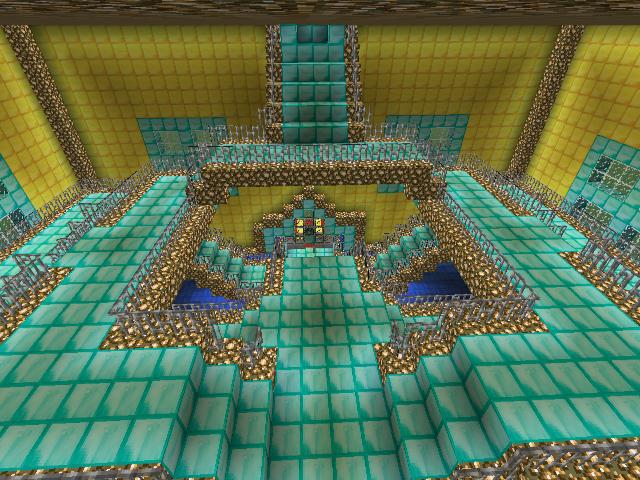Hitler never saw it coming. The four-picture progression cleverly relives the epic ending of Bionic Commando when Master-D (we all know it was Hitler) is destroyed. Ah, what a moment-- now preserved eternally in all its 8-bit splendor.
| |||
8 Bit Justice
| |||
Mastermind of pixilated pop art, Chris Olan AKA 8-Bit Artist, has made a name for himself in the realm of video game-inspired art. COIN-OP TV and RetroBlast take an inside look at Olan’s talents and inspiration.
| |||
How long have you been pursuing art, and how did you develop this unique style? “I’ve been painting for a little over a year now. My birthday was coming up, and my friend, an artist, asked me what I wanted. I told her I wanted a Mega Man piece done, but unfortunately, she got busy and couldn’t do it for me. I wanted the piece so much, I just decided to do it myself. I fell in love with how the sprite came out using just paints. After that, it is all I ever wanted to paint.”
|
“My inspiration is of course both the NES and my childhood. I have such fond memories of it growing up. The wonderful and colorful characters of the NES is what really influenced my painting. I love capturing a moment of a game on canvas and having people get taken back to that time when they didn’t have a care in the world and their biggest worry was trying to save the princess.” |
How would you describe your style? “I've had people call my art lots of things: Pixelism, Pop Art, Neo-Dada Art and of course, Crap. I guess one could call it Pop Art since the NES is a pop icon, but I don't worry about a certain style or anything. If someone came up to me and asked me what I painted, I just smile and say, ‘I paint squares.’"
|
Do you think the relationship between art and video games will develop further in the future? “Absolutely. No matter how cool the gameplay or how well the game is done, if you don't have cool stuff to look at or have characters that don't stick in your head the game won't be as successful as it can be. The early NES games like Mario, Zelda, Metroid, Kid Icarus; they had such memorable characters, scenes, backgrounds, etc. It just enhanced the experience and that won't ever leave video games.”
|
Do you think retro gaming and style is making a comeback? Is it gaining popularity? “I think retro gaming is making a comeback, I mean, just look at all the different type of Nintendo shirts Hot Topic has! It has steadily been gaining popularity for while, although it is tough to say exactly why. My personal reason would be that games nowadays are much too complicated. I don't want to pop in Madden 2006 and be the QB and have to control my head, set my feet, and make sure I don't over throw and stuff like that or else my throw won’t be completed. I think it takes the fun out of it. I want to play Tecmo Bowl, be Bo Jackson and just have 25 rushing TD's in one game.”
|
Rodney Pygoya Chang
What my presented art mathematical model professes is that upon the perception of any art object, the complex interactions of the factors of this equation operate and function to produce a holistic overall response (or perception) to the aesthetic stimulus. Like a computer, the mind inputs the data and comes up with a conclusion or decision as output....The formula for an art making modality also de-emphasizes the importance of the specific art medium used, freeing the creator to use whatever material or technology is available for his perusal.
Sailing, Oil on Canvas, 1966
Next Century, Digital, 1985
Interface, Lithograph, 1986
Lover, Digital 1986
Picasso's Bullfight, Digital/Woodcut, 1989
Street Beat, Digital Oil, 1987
Fleeting Love, Revolving Fan/Surgical Gloves, Photo, Glasses, Penlight, Oral Cotton Rolls, 2 lb. Fishing Line, 1987
Nuclear Moon Glow, Digital/Serigraph, 1986
Outpost, Digital, 1986
Painting on Location, Digital Oil, 2003
Pink Tidal Lights, Digital Giclee, 2003
Portal to Cyberspace, Oil on Canvas, 1997
Go With the Flow, Oil on Canvas, 2003
Assembly, Oil on Canvas, 1986
Karl Lilje
Born in 1972. Living in Cape Town, South Africa, Lilje takes famous photographs and pixelates them using software.
Adam Connelly
"I was born in 1974, in Ann Arbor, Michigan and lived there for sixteen years". " I have a BFA from UC Santa Cruz where I studied painting, printmaking, and photography, graduating in 1996. Since then, I have worked as a graphic designer with companies such as Sega, Pixar, CNET, and Apple Computer".
"Specializing in interactive and motion graphics work as a designer has directly influenced my artwork". "It compelled me to examine where the borders of the digital and the analog world meet, and how social, cultural, and ideological trends are shaped by technology and art".
Adam Connelly's was much different to other pixelist artists. What he did was take Pornographic pictures and pixelate them so you couldn't see the picture very well but you are still able to see what the image really is.
  
This is his own website which i found,
http://www.adamconnelly.com/gallery/index.html
Patrick Egarter
Patrick Egarter is the best pixelist artist i have researched so far, he makes pixel pictures by using paint, he makes his art in the same way a pointillist artist would make there artwork. His work takes hours and hours to complete and because of this there are no images of his work, only thumbnails. His work is shown by video, he films himself creating his work.
This is Vimeo account were all of his videos are.
|









No comments:
Post a Comment